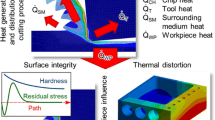Abstract
This contributed volume contains the summarised results of the Priority Programme (PP) 1480 “Modelling, Simulation and Compensation of Thermal Effects for Complex Machining Processes”, which was funded by the German Research Foundation (germ.: Deutsche Forschungsgemeinschaft—DFG) in the period from 2010 to 2016. Within the framework of this PP collaborative teams of machining experts on the one hand and researchers from the fields of mechanics, thermodynamics, mathematics as well as materials science at the other hand worked together on an interdisciplinary level to solve the workpiece-related problems resulting from heat effects in machining operations. The twelve projects focused on various processes such as turning, milling, drilling, deep hole drilling, gear hobbing as well as grinding and developed particular novel predictive simulation-based compensation methods for the minimisation of thermally induced impacts on the component during machining.
Access provided by CONRICYT-eBooks. Download chapter PDF
Similar content being viewed by others
This contributed volume contains the summarised final results of the Priority Programme (PP) 1480 “Modelling, Simulation and Compensation of Thermal Effects for Complex Machining Processes”, which was funded by the German Research Foundation (germ.: Deutsche Forschungsgemeinschaft—DFG) in the period from 2010 to 2016. Within the framework of this PP collaborative teams of machining experts on the one hand and researchers from the fields of mechanics, thermodynamics, mathematics as well as materials science on the other hand worked together on an interdisciplinary level to solve the workpiece-related problems resulting from heat effects in complex machining operations (see Fig. 1). Various processes, such as turning, milling, drilling, deep hole drilling, hobbing as well as grinding were investigated by twelve research projects, which developed particular simulation-based prediction and compensation methods for the minimisation of thermally induced impacts on the component machined.
Three working groups, focusing on measurement technology, modelling and simulation techniques as well as on material and friction modelling, were initiated at the beginning of the PP 1480 to promote the scientific exchange among the projects by realising a wide range of activities such as meetings, workshops and round robin tests. Three consecutively stages ensured the structured attainment of the programmes objectives (Fig. 2).
The first stage “feasibility” contains fundamental investigations aiming at the determination of the process heat source as well as the initial modelling and simulation of its impact on the workpiece. Within the second project stage called “flexibility” the models were enhanced and complex part shapes as well as, if necessary, multiple heat sources were considered. The last third stage entitled “compensation” utilised the simulation approaches developed in the first two phases for the prediction of thermal distortion and subsurface damage caused by the corresponding machining operation. The following chapters present a summary of the working group activities (Part 1) and the final results of the individual research projects (Part 2).
Author information
Authors and Affiliations
Corresponding author
Editor information
Editors and Affiliations
Rights and permissions
Copyright information
© 2018 Springer International Publishing AG
About this chapter
Cite this chapter
Biermann, D., Hollmann, F. (2018). Introduction. In: Biermann, D., Hollmann, F. (eds) Thermal Effects in Complex Machining Processes. Lecture Notes in Production Engineering. Springer, Cham. https://doi.org/10.1007/978-3-319-57120-1_1
Download citation
DOI: https://doi.org/10.1007/978-3-319-57120-1_1
Published:
Publisher Name: Springer, Cham
Print ISBN: 978-3-319-57119-5
Online ISBN: 978-3-319-57120-1
eBook Packages: EngineeringEngineering (R0)






